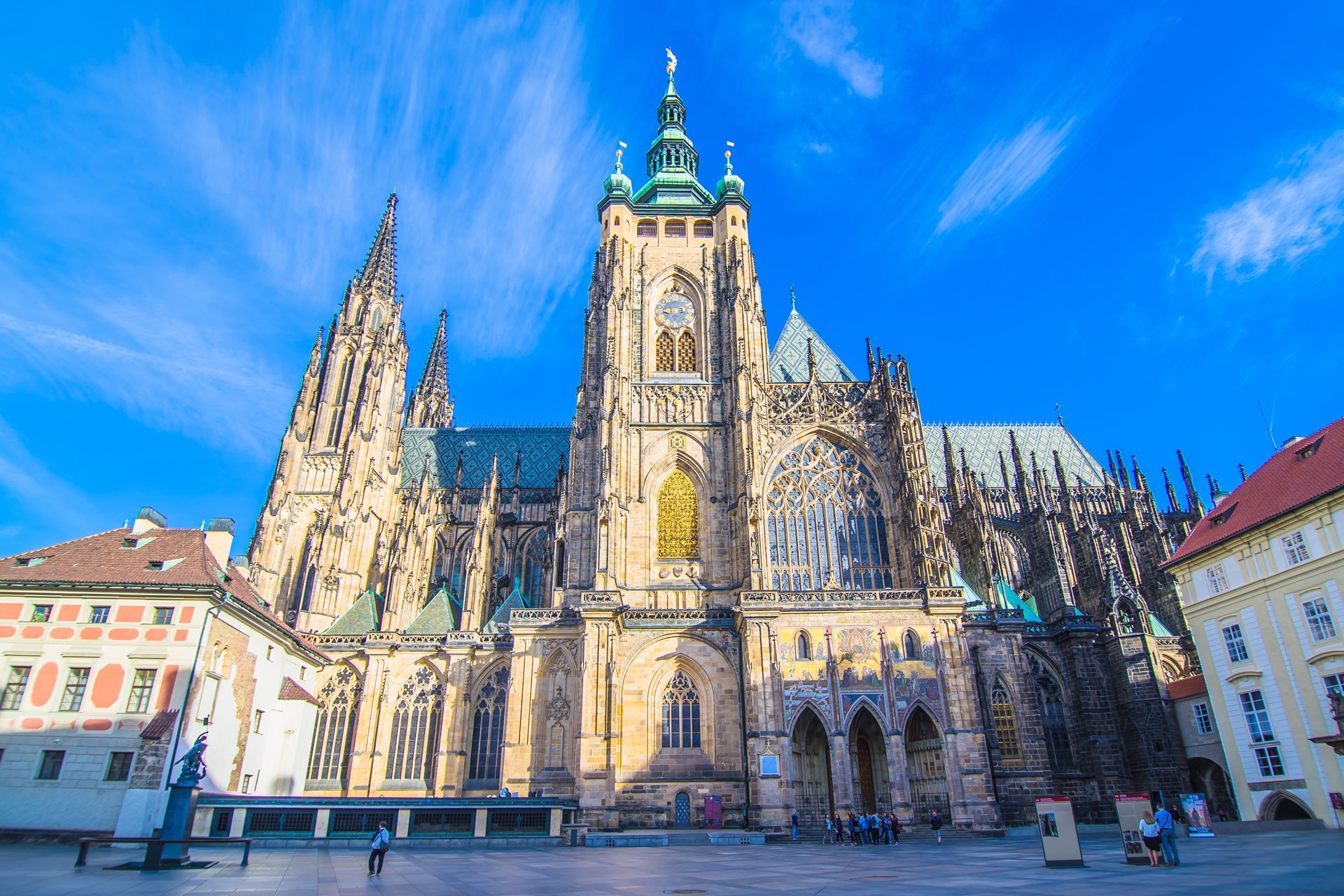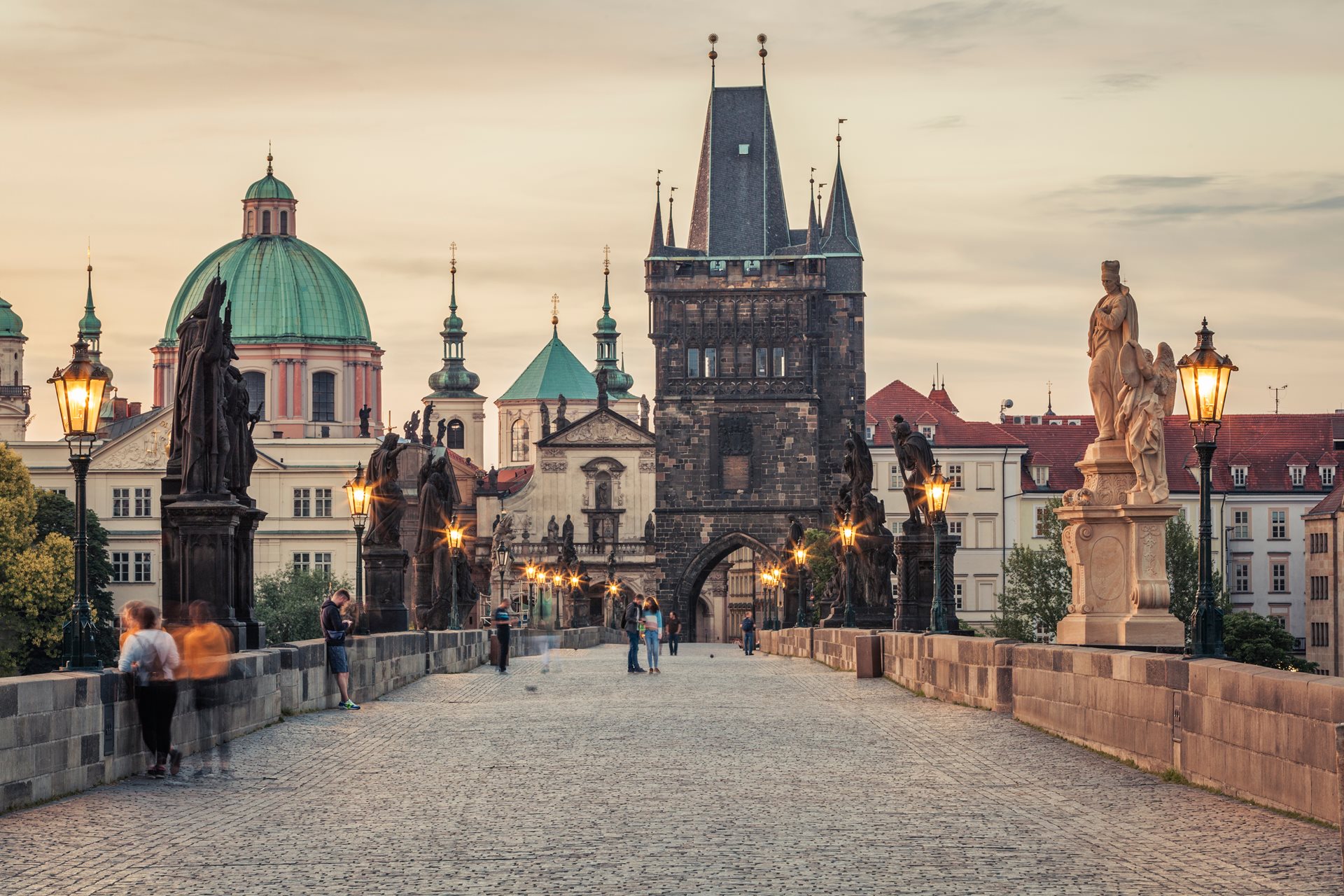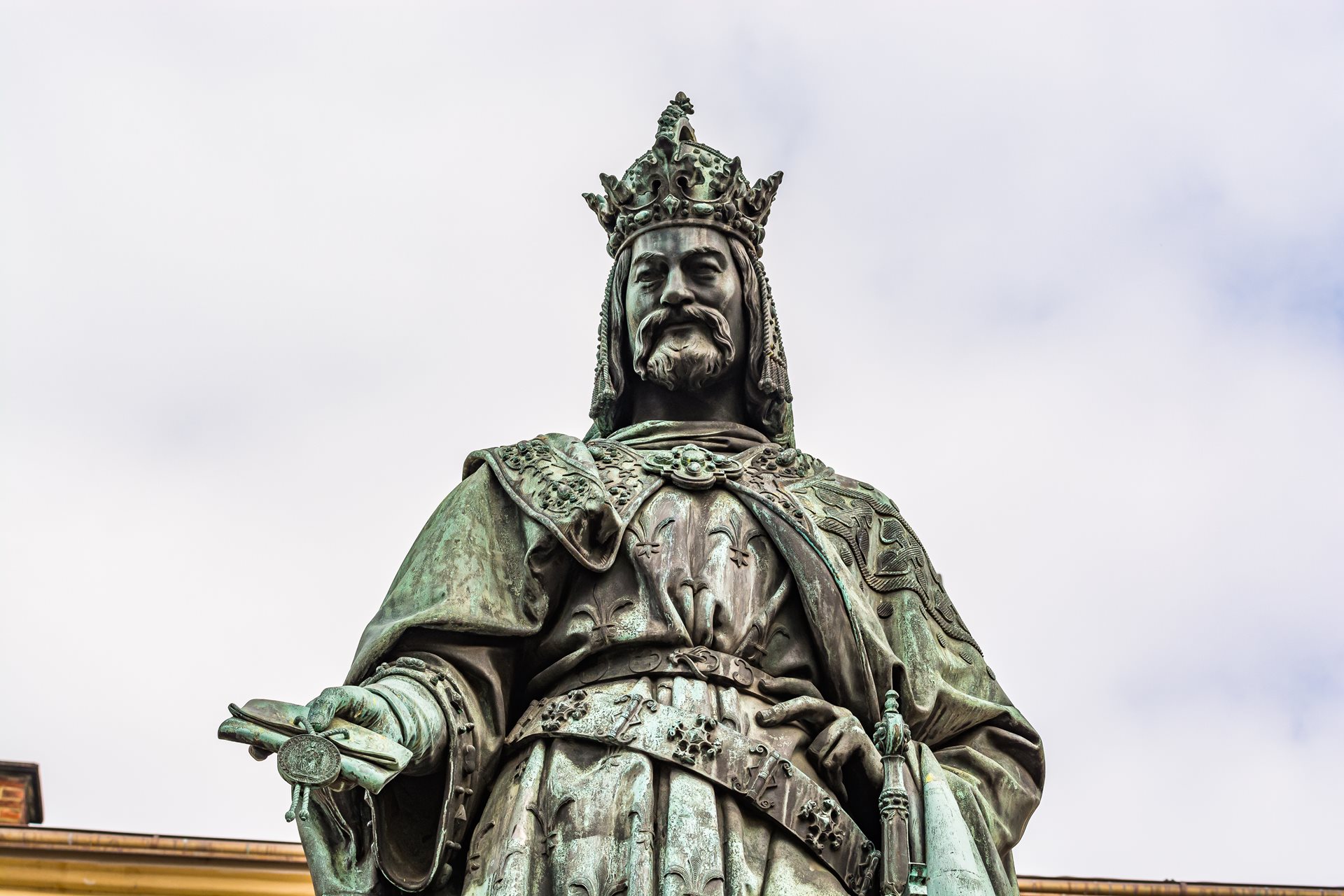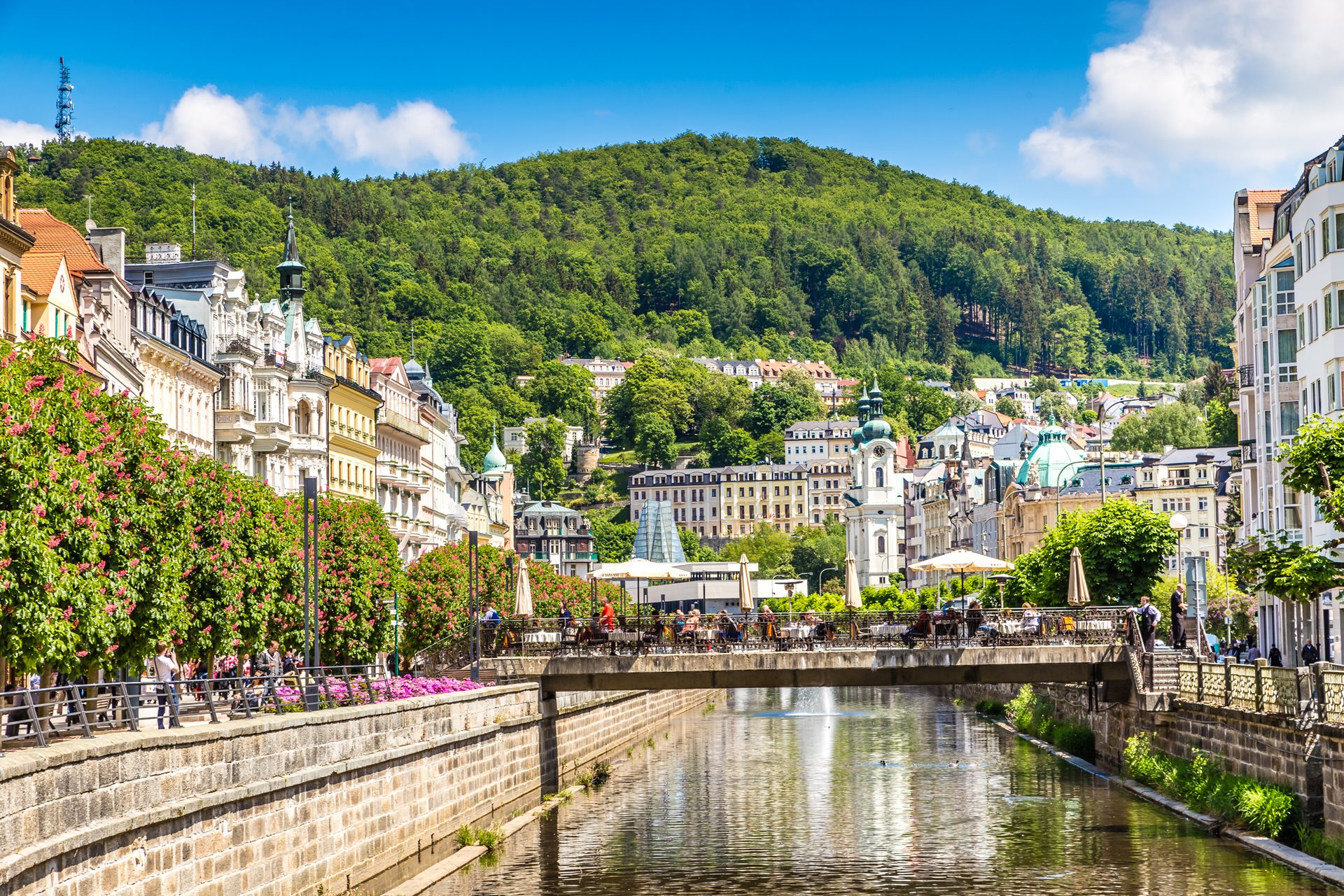Charles IV is a very positively perceived ruler in the Czech Republic. And that’s not only because his portrait is on the 100-crown banknote. He is even appreciated as one of the most capable and best rulers in Czech history. When the Czech people chose the greatest personality of their history some time ago, Charles IV won the TV voting comfortably.
Vita Caroli – Charles life
It’s already been several centuries since Charles IV lived. Who was he actually? Charles, born Wenceslaus, was born on 14 May 1316 in Prague as the first son of John of Bohemia and Elizabeth of Bohemia. His father was King of Bohemia and count of Luxembourg, his mother was an heiress to an ancient Přemyslid dynasty of kings of Bohemia who had died out in the male line. Charles was brought up at a French court in Paris and was one of the first kings of Bohemia who could read and write. He even corresponded personally with leading philosophers of that time, such as Petrarch, and Pope Clement VI was his friend. Charles IV chose Prague as his city of residence and from there he ruled over his territory. Charles was Roman Emperor, King of Bohemia, King of Lombardy and King of Burgundy, Count of Luxembourg, Margrave of Moravia and possessed many other titles. As a result, he was one of the leading rulers of the High Middle Ages. Charles was extraordinarily educated and intelligent, he spoke five languages fluently and he even wrote his own biography titled Vita Caroli. From the position of Roman Emperor he had the Golden Bull written. It was the most important constitutional law of the empire that was in force until the demise of the Holy Roman Empire in 1806. Charles IV died aged 62 in 1378. He was buried in the crypt of St Vitus Cathedral at Prague Castle.Charles’ traces in Prague
Prague Castle complex
Charles IV chose Prague as his city of residence, the capital of the Kingdom of Bohemia. When he came back to Prague as a young man after travelling around Europe, he had no place for accommodation because Prague Castle had been in ruins for several decades. So, his first trace in Prague that we’ve been able see to this day is the reconstruction of Prague Castle based on the then state-of-the-art French Gothic style. Charles IV had the castle converted into a palace similar to the palace of French kings where he lived as a teenager. These days, you can find the remains of the Gothic palace in the Old Royal Palace. At the same time, he also had the old Romanesque triple-naved Basilica of St Vitus torn down and began the construction of a monumental Gothic cathedral. We’ve been able to admire its complete beauty to this day even though the whole construction took about 600 years… However, the oldest part near the altar really remembers Charles IV as its construction started in 1344. St Wenceslas Chapel can be called a highlight of Gothic architecture. Charles spared no expense on the chapel, he wanted to pay tribute to his sanctified ancestor in the best way.
Charles Bridge
Nowadays, Prague Castle and the cathedral are part of the Prague skyline and Prague wouldn’t be Prague without them. However, another piece of the heritage of Charles IV even bears his name. It is Charles Bridge. It replaced the older stone Judith Bridge which had been swept away by a flood. The construction of a stone bridge over a wide river wasn’t exactly easy in technological terms in the 14th century. That’s also why the whole construction work lasted 45 years. Today, Charles Bridge is one of the most-visited monuments of the entire Czech Republic. Those who haven’t got a photograph of Charles Bridge and Prague Castle actually haven’t been to Prague at all.
New Town of Prague
Prague also expanded thanks to Charles IV. And this trace left by him may be the most important trace although it isn’t visible at first sight. Prague residents were crammed into small houses attached to one another in the area of what is now the Old Town. The city walls of Prague hindered development and no sewerage system as well as tortuous narrow streets weren’t beneficial to the city. Therefore, Charles IV founded the New Town of Prague just outside the city walls in 1348. The construction of Prague in the Gothic style became the biggest ever one-off work of European medieval architecture. The New Town was founded in an area nearly three times larger than the area previously encompassed by the Old Town. It was situated in around three hundred and sixty hectares and extended from Vyšehrad all the way to Vítkov Hill – thus surrounding the entire Old Town. The architectural plan was laid down clearly – strictly delimited straight streets up to 26 metres wide, three large squares (present-day Charles (Karlovo) Square, Wenceslas Square and Senovážné Square) and several then modern and giant churches and monasteries. Thanks to quality plans, Prague could expand for around 500 years securely within its city walls, and the present-day Prague centre has been drawing on Charles’ concept of the city to this day.
Charles University
The year 1348 again. At that time, Charles IV succeeded in obtaining an important permission from the Pope – to establish a university. Those who wanted to study before that year had to leave for Italy, France, Spain or England to study there. Higher education was missing in the region of Central and Eastern Europe. Charles decided to change that and, after diplomatic efforts that lasted several years, it happened. The University of Prague, currently Charles University, soon gained renown and instruction took place at four faculties – the faculties of theology, law, medicine and arts. And where was the university located? Charles founded the Carolinum college. It’s currently situated right next to the Estates Theatre near Old Town Square. These days, the university rectorate has its seat there and it is the venue of graduations and matriculations as well.
Construction projects beyond Prague borders
Karlštejn Castle
Charles IV was an active ruler who perhaps couldn’t be bored at all. Courtesy of his diplomacy, Prague and the Kingdom of Bohemia found themselves in their heyday. This was also reflected in other construction projects outside Prague. For instance, Charles founded another monument that isn’t missed by nearly any visitor to the Czech Republic, the majestic Karlštejn Castle in central Bohemia. It was founded – when else – also in 1348 as a private residence of the King of Bohemia and Roman Emperor. Over the course of time, the purpose of the castle changed and it became a medieval treasury where the Roman crown jewels and a collection of holy relics were safekept. The castle was built in the Gothic style period, and during a tour you have an opportunity to visit the medieval chambers of the king himself with the original wooden panelling or, if you make a reservation in advance, also the Chapel of the Holy Cross covered with gold, precious stones and panel paintings. Although Karlštejn is currently undergoing renovation, it is still open to tourists.
Karlovy Vary
When you set off to the west of Bohemia, definitely don’t leave out a visit to Karlovy Vary (Carlsbad), a world-famous spa city. As its name suggests, the city was founded by Charles IV as thermal baths as it was a place where hot springs rose from the ground and where people used to go bathing and cure their ailments. No historic sights dating back to the time of its foundation have been preserved in Karlovy Vary, but when you take a dip in the thermal baths, you can remember that Charles IV made use of the same hot springs and cured his ailments there more than 600 years ago.





-(1).jpg?width=1920&height=1204&ext=.jpg)




